how to draw a 3d shadow
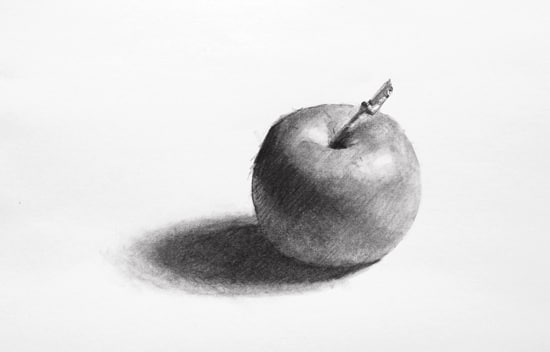
In this low-cal and shadow series, we look at the theory, drawing and painting of a simple form focusing on shadow, light and edges.
in Part ane, nosotros looked at the theory of light and shadow.
This week we're going to put pencil to paper and see how the theory works in a uncomplicated pencil cartoon of an apple…
Understanding your light source
The different characteristics of the lite hitting an object tin completely change its appearance.
For this demonstration, I've created a lighting set up up using one single lite source which gives u.s. a predictable fall of light.
This gear up demonstrates each distinct area to be aware of, exaggerating the widest tonal range, and when yous're a beginner, it's the simplest way to see the difference between the tones.
My lamp has a diffuser on information technology called a Softbox.
The Softbox gives us the fall of light we're subsequently, yet slightly softer edges on the shadows.
Why?
One of the cardinal lessons from this demonstration I want you lot to come up away with is to empathize the importance of soft edges in your drawings.
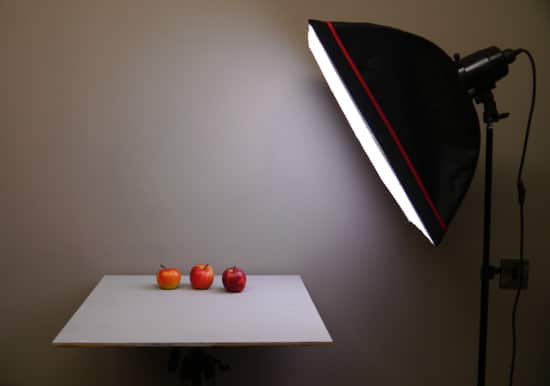
Softbox single source lighting set up in my studio
The importance of hard & soft edges
An edge is where ii objects or ii surfaces meet together.
The term a 'difficult edge' can depict two very hard surfaces, such as a tabletop with a metallic cube on top of it or nearly ordinarily in drawing, we talk almost the hard border being an surface area that has a sharpness to information technology or a focal bespeak of the picture.
And then, it could be a crisp line to point changes in shape or angularity.
Or information technology could be an area of high contrast (calorie-free and dark) to depict the viewer's attention.
A 'soft edge' is more flowing or fluid and tends to be more low in contrast. Soft edges suggest the thought of roundness and a gradual transition.
In photography, lighting tin can often be chosen difficult light or soft light. Difficult lite is harsh lite and so creates sharp shadows and harder edges.
Soft light is very diffused, creating softer shadows and softer edges. So if yous wanted to photograph somebody in the near flattering light, you would accept soft light. If you want to increase the dramatic quality of the scene, you would use difficult calorie-free.
This one piece of data that tin drastically change your drawings and paintings.
Then equally we go through the next demo, I'll indicate the areas to continue soft and the areas to continue sharper.
One of the biggest mistakes beginners make in drawing, is keeping all of the edges the aforementioned – most commonly, all of the edges are kept abrupt and crisp.
If you can acquire to alter the weight of line and to comprise more soft edges in your drawings, information technology will make a massive difference to the realism and way of your work.
Shadow edge
Below are ii photographs to illustrate the subtle differences in the shadow strengths when I altered the lighting slightly.
The first ane used direct sunlight because information technology's not diffused; information technology has created a harder, more solid shadow line and cast shadow.
Too, come across how you can guess the bending of the sun via the length of the cast shadow and the brilliant highlight.
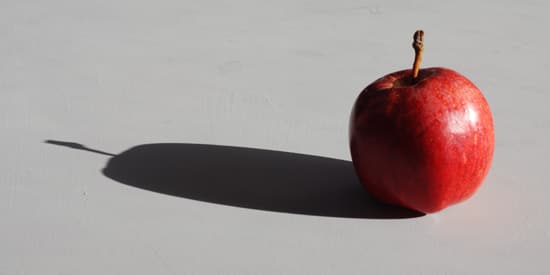
Low bending, hard lighting from directly sunlight.
The second one used a slightly higher lighting position with a softer light creating a softer cast shadow edge.
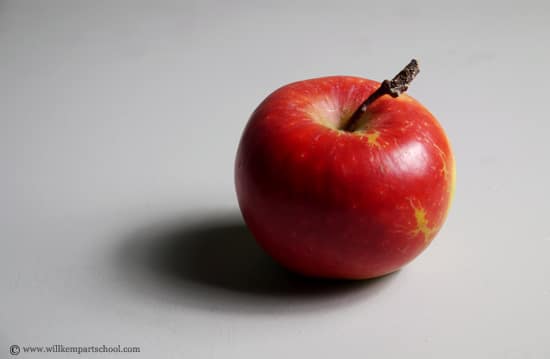
High, softer diffused lighting from a unmarried lite source Softbox
The paradigm in a higher place is the final reference image I'll use for this demonstration.
It can exist 'right clicked' and 'Save image every bit', so yous tin use information technology equally a reference for your drawing.
Home setup
A small-scale table lamp without a shade is a good choice for setting upwardly your notwithstanding life at domicile, if you lot want to work from life, rather than the photograph above.
An opaque bulb will give you a light source in between the ii examples above. O.k – yous won't have a diffuser to mimic a Softbox – but it won't exist every bit difficult as direct sunlight either.
Simplifying your drawings by mapping the shadows
Before we get started on the principal event, hither's a really quick fashion of practising looking for the shadow line.
Don't underestimate its importance because of its simplicity.
It's frequently the get-go sketch that is the nigh effective at conveying the sense of class rather than an overworked, detailed drawing.
However, working with pencil, subtleties tin can get added into the scene (that are at that place) too early, and the simple distinction between light and dark gets lost.
During this exercise, you lot have to make a clear stardom between light and dark because y'all are using a pen – helping to prevent the separation from becoming muddled.
Pro tip: Working with a permanent marker pen is the best method I've constitute for practising this technique. It forces you to make a clean decision in your mind earlier committing pen to newspaper.
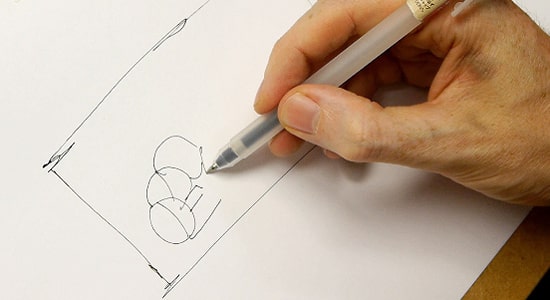
This sketch is based on the Cézanne painting from last week. I'thousand using a black, fine line gel pen. This i is 0.five mm from Muji.
I sketch out the outline of the object then put in both the cast shadow and the shadow line.
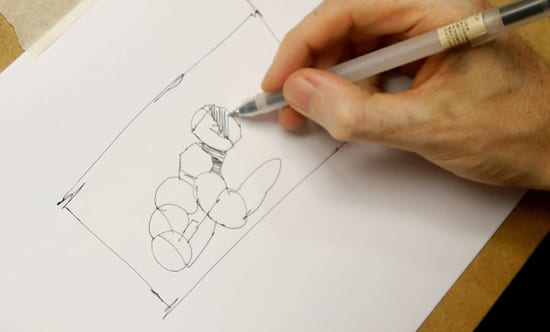
I can then indicate the shadow side by hatching lines with the pen.
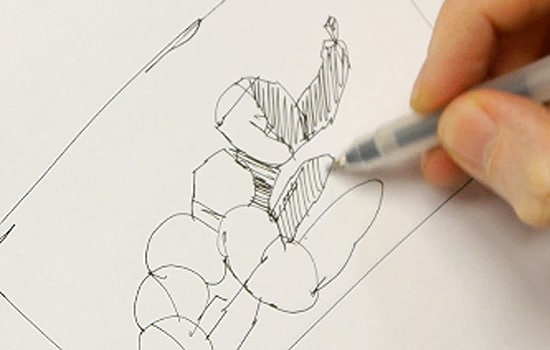
I'chiliad keeping the lines evenly spaced and changing the direction of them, depending on the management of the form. Notice how all of the cast shadows on the table are hatched in the same direction.
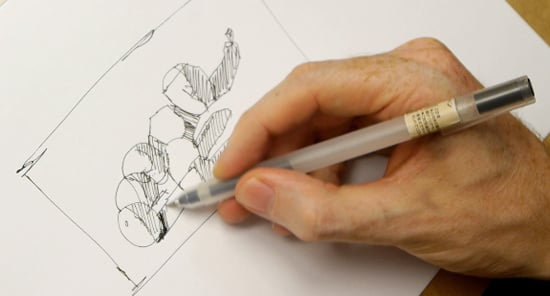
I then draw in any darker accents on the bottom of the objects.
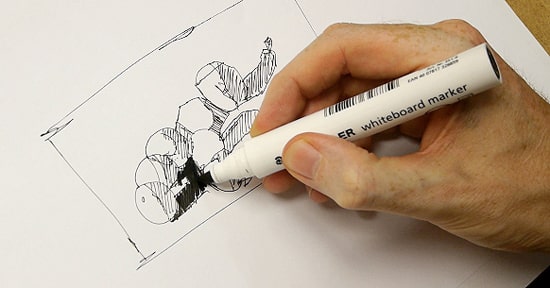
And once I'm confident with the general shapes and shadow patterns, I work with a thicker pen (this is a Staedler whiteboard marker) to indicate the very darkest cast shadows inside the cartoon.
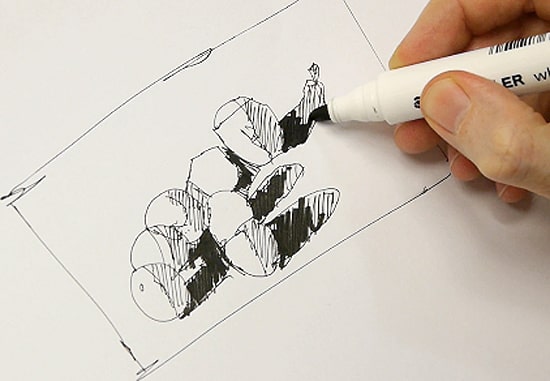
So now I have three tones, the lights, the form shadows and the cast shadows.
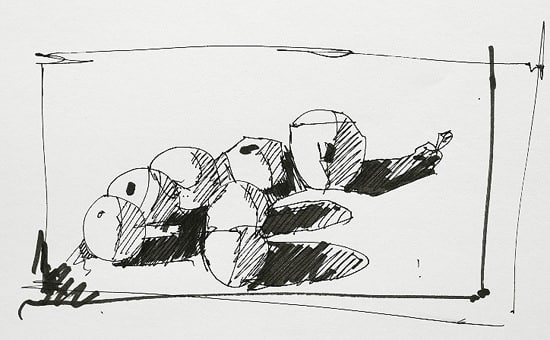
This has just given me a really skilful thought of the shadow patterns within the scene. It can be a great exercise to exercise if you're out in bright sunlight equally you can get distinct shadow shapes.
And then now your eyes are tuned in, permit'due south get on with the form drawing using a pencil.
How to depict a three-dimensional Apple tree

Materials you will need:
- White newspaper, either regular computer paper or cartridge paper
- 2B & 6B pencil – I employ Staedtler Mars Lumograph
- Eraser – I employ a putty eraser
- A round object to draw around (approx 7cm wide)
- A tortillion – I utilize a paper stump, which is very similar to compressed newspaper.

Find a circular object to draw lightly effectually; this helps to give you a starting indicate so we can apace put into practice the theory of the sphere from concluding week. I'm using to 2B pencil (Staedtler Mars Lumograph)
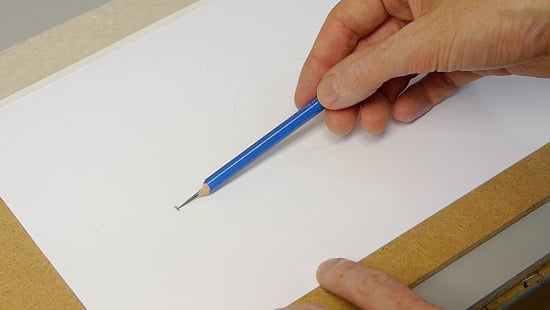
I then make a mark indicating the furthest point of the cast shadow.
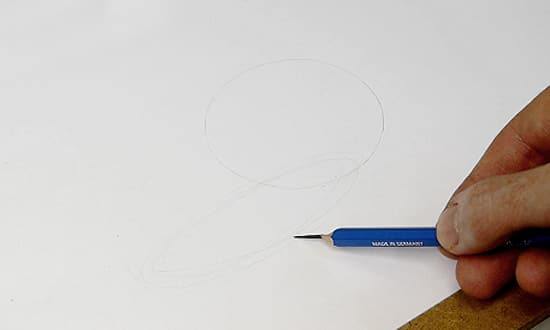
Lightly draw an ellipse shape to indicate the bandage shadow. Observe how the ellipse cuts through the shape of the circle.
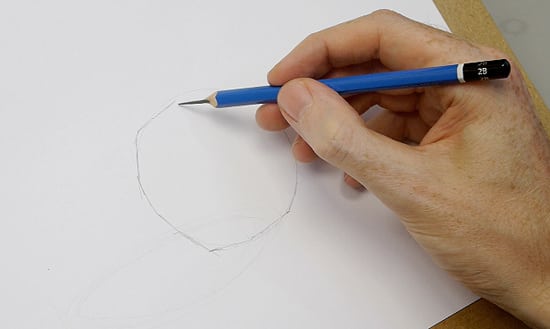
I at present utilise a hard line and add slight angles to the circle, to represent more than accurately the shape of the apple tree.
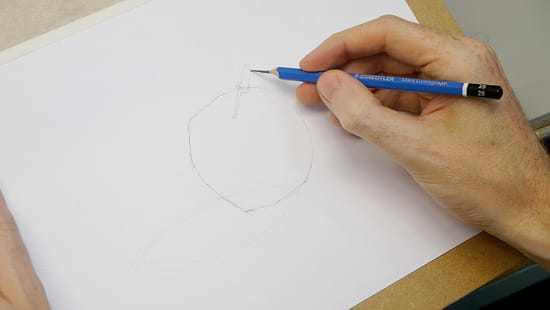
Lightly draw in the shape of the stalk.
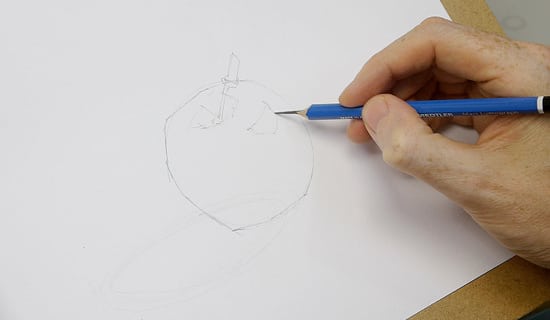
And and so the shape of the highlight.
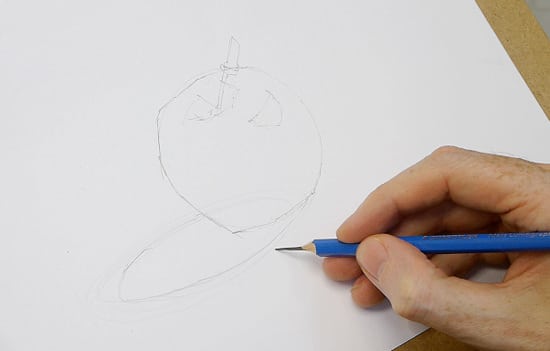
Reinforce the cast shadow shape noticing – the darkest part that sits directly under the apple tree, the mid-tone that makes upwards the majority of the cast shadow shape while keeping a lighter line as you become towards the brightest, softest tail of the cast shadow.
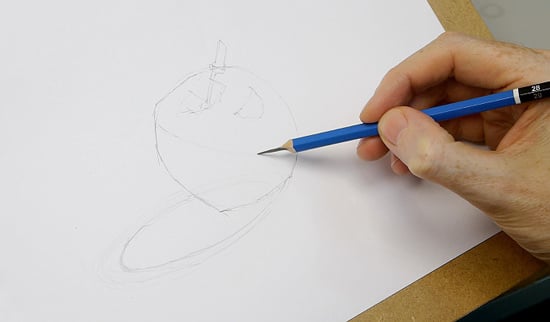
Lightly draw the shadow line; it has a slight curve to information technology.
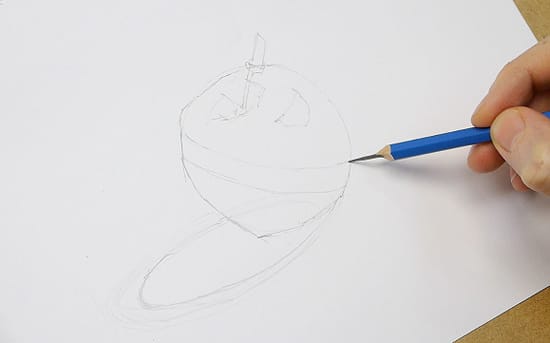
The curved line below the shadow line indicates a band where the form shadow core falls within. This will be the darkest area of the apple.
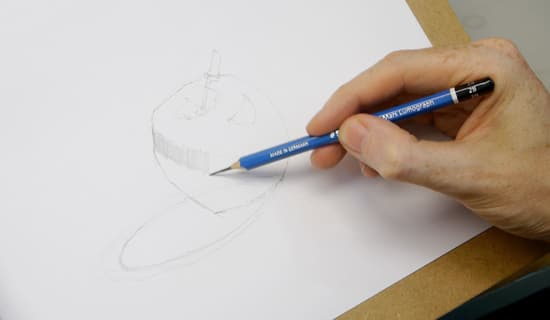
I then shade a mid-tone along this class shadow core. Even though it'due south going to exist darker than this somewhen, information technology will help you to judge the different tones within the drawing.
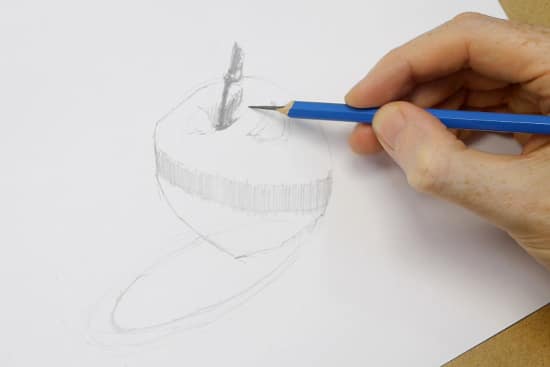
Shade the apple stalk every bit nighttime as y'all tin can get it, it's practically blackness on the reference image and it doesn't need to blend into whatever other tones – so nosotros tin can afford to become as dark as possible.
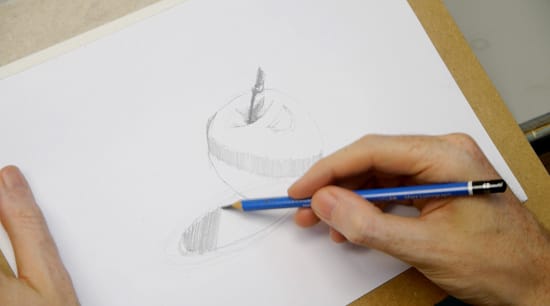
At present I swap to a softer pencil (a 6B) and begin to shade in the majority of the cast shadow. Notice how the angle of the shading is the aforementioned every bit when I hatched the bandage shadow in the shadow mapping cartoon using a pen.
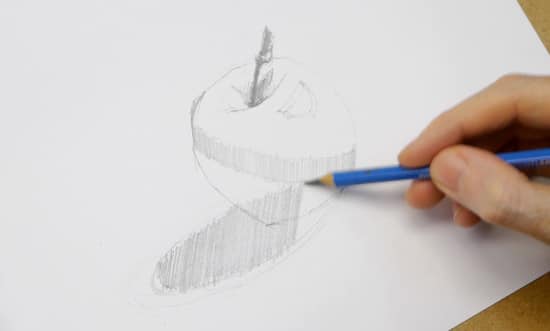
Continue the shade over the edge of the apple, and this is called combining the shadow shapes.
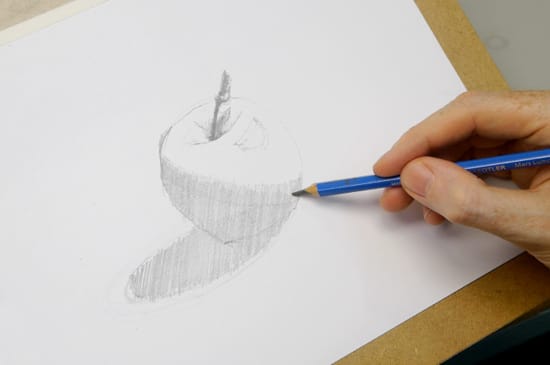
I fill up in the form shadow, working over the start, form shadow core band.
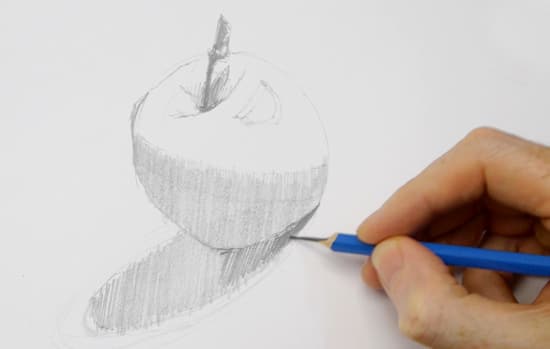
Information technology's at this point I swap back to the 2B and draw the hard, precipitous line at the base of the cast shadow.
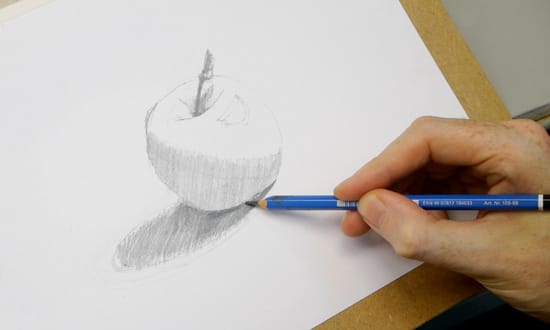
Using the softer 6B pencil, I reinforce the cast shadow depth of tone.
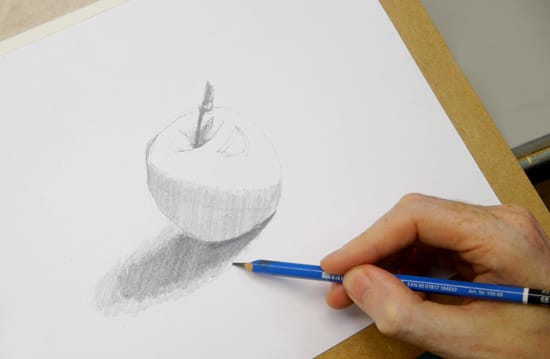
Holding the pencil lightly, I gently indicate the softer, lighter tail of the cast shadow.
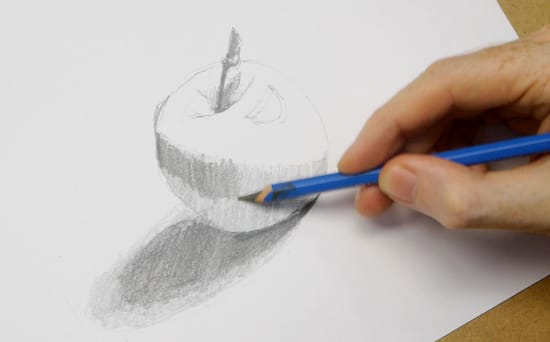
Now I feel confident to go heavier on the form shadow core equally I have both the dark cast shadow and the dark stalk to guess against.
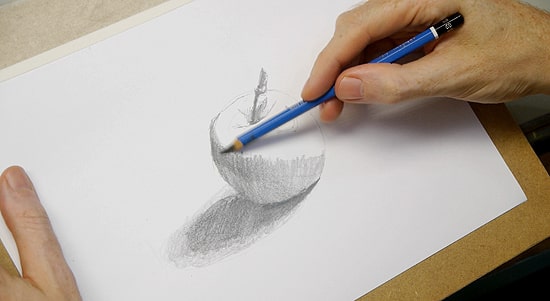
Changing hand position, I tin can follow the shape of the form.
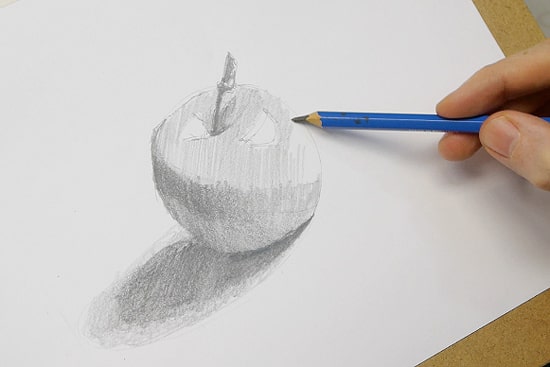
Lightly work across the whole of the light side to indicate the halftone.
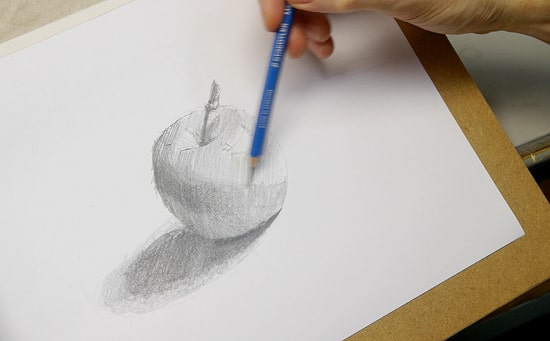
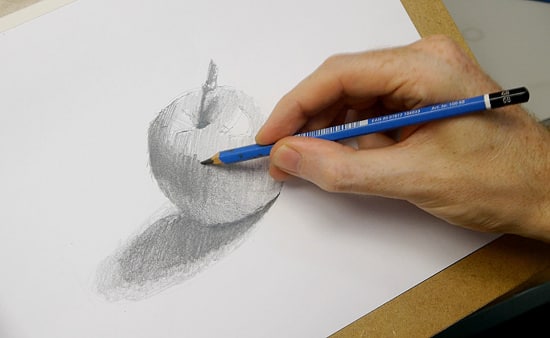
Now nosotros have established all the elements.
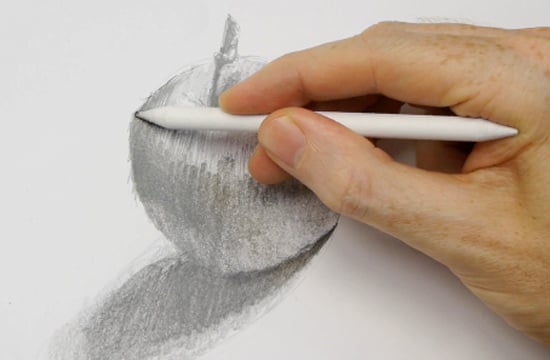
Using our secret weapon, our paper stump I start to alloy the tones to achieve the soft transition between the light side and the shadow side.

Notice how when yous shade with the paper stump, it slightly darkens the tone.
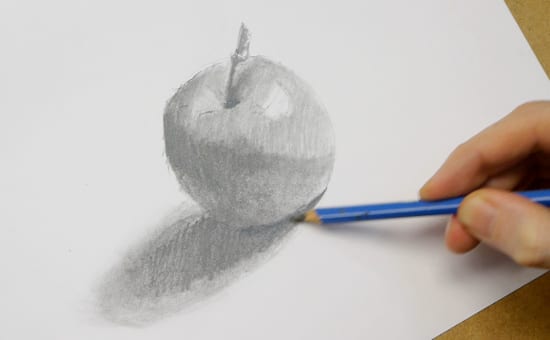
I go along to work between softening and sharpening and blending.
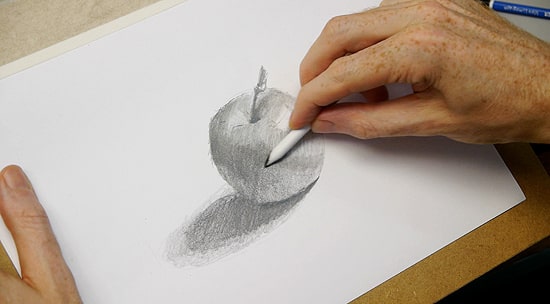

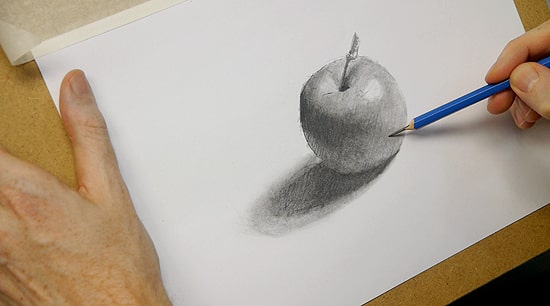
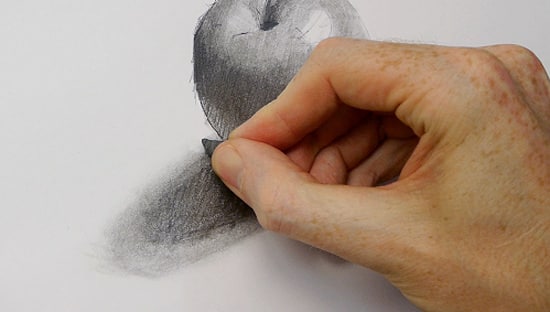
Using a putty eraser, I take back any of the shapes that have gone slightly out.
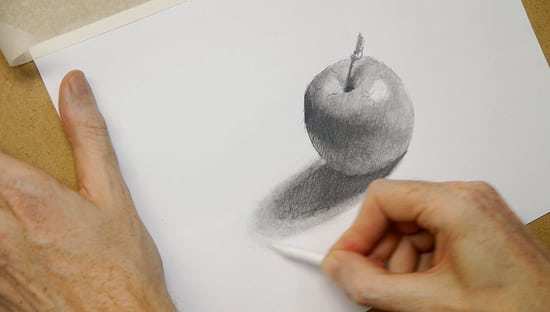
Soften out the tail of the cast shadow.
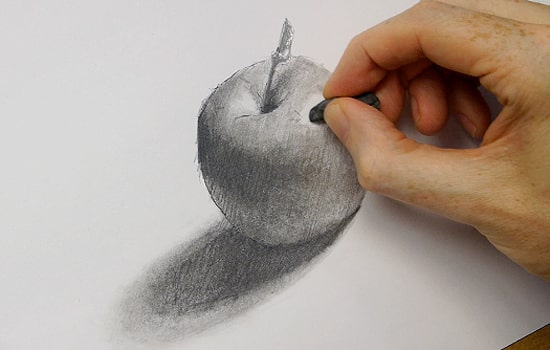
Pull back the highlight on the light side of the apple.

The finished cartoon.
Whether y'all download and apply the reference image or fix your written report, have information technology a step at a time, look out for the soft transitions, and I hope you go some fantastic results!
Side by side time we'll be back in the studio where we'll develop this apple tree study into a simple contemporary painting.
If you'd like to larn more than about sfumato and cartoon techniques, you should have a wait at the How to draw light & shadow online cartoon course
You might also like:
1. A Beginners Guide to Lite & Shadow: Function 1
2. A Beginners Guide to Low-cal & Shadow: Role iii
Source: https://willkempartschool.com/how-to-shade-a-drawing-light-shadow-part-2/
0 Response to "how to draw a 3d shadow"
Post a Comment